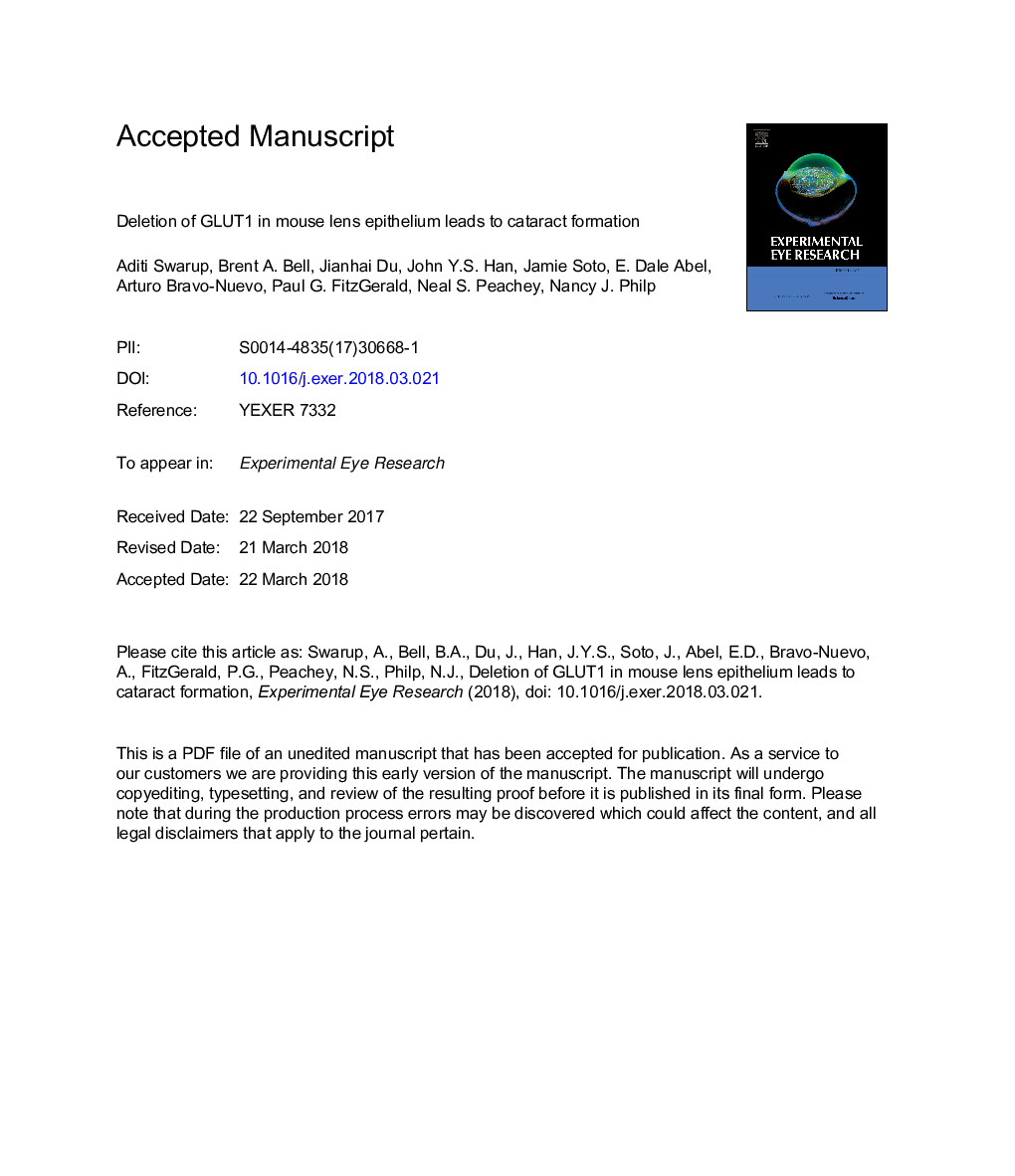| کد مقاله | کد نشریه | سال انتشار | مقاله انگلیسی | نسخه تمام متن |
|---|---|---|---|---|
| 8791962 | 1602550 | 2018 | 31 صفحه PDF | دانلود رایگان |
عنوان انگلیسی مقاله ISI
Deletion of GLUT1 in mouse lens epithelium leads to cataract formation
دانلود مقاله + سفارش ترجمه
دانلود مقاله ISI انگلیسی
رایگان برای ایرانیان
کلمات کلیدی
موضوعات مرتبط
علوم زیستی و بیوفناوری
ایمنی شناسی و میکروب شناسی
ایمونولوژی و میکروب شناسی (عمومی)
پیش نمایش صفحه اول مقاله

چکیده انگلیسی
The primary energy substrate of the lens is glucose and uptake of glucose from the aqueous humor is dependent on glucose transporters. GLUT1, the facilitated glucose transporter encoded by Slc2a1 is expressed in the epithelium of bovine, human and rat lenses. In the current study, we examined the expression of GLUT1 in the mouse lens and determined its role in maintaining lens transparency by studying effects of postnatal deletion of Slc2a1. In situ hybridization and immunofluorescence labeling were used to determine the expression and subcellular distribution of GLUT1 in the lens. Slc2a1 was knocked out of the lens epithelium by crossing transgenic mice expressing Cre recombinase under control of the GFAP promoter with Slc2a1loxP/loxP mice to generate Slc2a1loxP/loxP;GFAP-Cre+/0 (LensÎGlut1) mice. LensÎGlut1 mice developed visible lens opacities by around 3 months of age, which corresponded temporally with the total loss of detectable GLUT1 expression in the lens. Spectral domain optical coherence tomography (SD-OCT) imaging was used to monitor the formation of cataracts over time. SD-OCT imaging revealed that small nuclear cataracts were first apparent in the lenses of LensÎGlut1 mice beginning at about 2.7 months of age. Longitudinal SD-OCT imaging of LensÎGlut1 mice revealed disruption of mature secondary fiber cells after 3 months of age. Histological sections of eyes from LensÎGlut1 mice confirmed the disruption of the secondary fiber cells. The structural changes were most pronounced in fiber cells that had lost their organelles. In contrast, the histology of the lens epithelium in these mice appeared normal. Lactate and ATP were measured in lenses from LensÎGlut1 and control mice at 2 and 3 months of age. At 2 months of age, when GLUT1 was still detectable in the lens epithelium, albeit at low levels, the amount of lactate and ATP were not significantly different from controls. However, in lenses isolated from 3-month-old LensÎGlut1 mice, when GLUT1 was no longer detectable, levels of lactate and ATP were 50% lower than controls. Our findings demonstrate that in vivo, the transparency of mature lens fiber cells was dependent on glycolysis for ATP and the loss of GLUT1 transporters led to cataract formation. In contrast, lens epithelium and cortical fiber cells have mitochondria and could utilize other substrates to support their anabolic and catabolic needs.
ناشر
Database: Elsevier - ScienceDirect (ساینس دایرکت)
Journal: Experimental Eye Research - Volume 172, July 2018, Pages 45-53
Journal: Experimental Eye Research - Volume 172, July 2018, Pages 45-53
نویسندگان
Aditi Swarup, Brent A. Bell, Jianhai Du, John Y.S. Han, Jamie Soto, E. Dale Abel, Arturo Bravo-Nuevo, Paul G. FitzGerald, Neal S. Peachey, Nancy J. Philp,